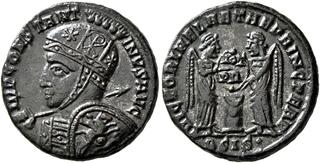| Leu Numismatik AG > Auction 15 | Auction date: 1 June 2024 |
| Lot number: 306 Price realized: This lot is for sale in an upcoming auction - Bid on this lot  | Show similar lots on CoinArchives Find similar lots in upcoming auctions on |
| Lot description: Constantine I, 307/310-337. Follis (Bronze, 18 mm, 2.83 g, 7 h), Siscia, 319. IMP CONSTANT-INVS AVG Helmeted and cuirassed bust of Constantine to left, holding spear over his right shoulder and with a shield, decorated with a horseman spearing a fallen foe, over his left shoulder; on cross-bar of helmet, christogram. Rev. VICTORIAE LAETAE PRINC PERP / BSIS• Two victories holding shield inscribed VOT/PR over garlanded altar. RIC 61 and note. Extremely rare and arguably the finest known example of this incredibly important early Christian coinage. Minor smoothing, otherwise, extremely fine. This extremely rare follis sets itself apart with the appearance of a Christogram on the emperor's helmet, which is reminescent of the spectacular silver medallions likewise showing a small Christogram hidden in the helmet (RIC VII, Ticinum 36). A Christian symbol par excellence, there is now much debate over its significance during Constantine's lifetime. According to the traditional view, as narrated by Eusebius, the emperor saw a vision in the sky in 312, shortly before the Battle of the Milvian Bridge, of a cross in the sky set on the sun, along with the words 'ἐν τούτῳ νίκα' in Greek, meaning 'In this [sign], conquer.' Not understanding the message, the following night, Constantine had a dream, in which Christ explained to him it was his symbol and to use it in combat to secure victory. Afterwards, it became a powerful symbol of Constantine's supposed conversion, culminating in a dramatic issue of folles showing the labarum piercing a serpent on the reverse (see lot 307 below). While the Christogram was no doubt intertwined with Constantine's status as a victorious emperor, pagan symbolism continued to appear on his coinage for some time after 312. Perhaps more crucially, the henotheistic tendencies of the cult of Sol Invictus meant that the stark contrast between paganism and monotheistic Christianity was becoming blurred, and the symbol might have been acceptable to both pagans and Christians, until it was exclusively claimed by the latter during the course of the fourth century. Estimate: 1000 CHF |  |



